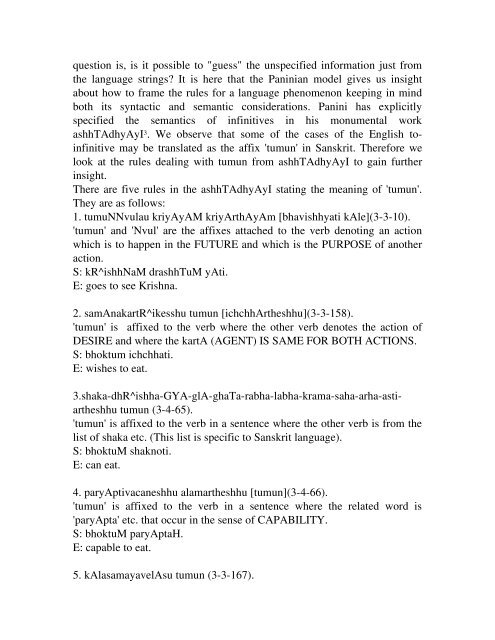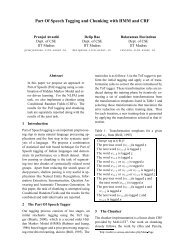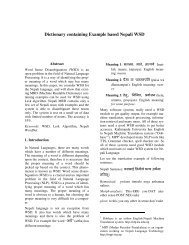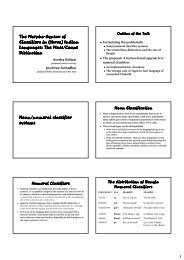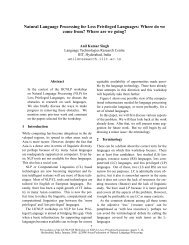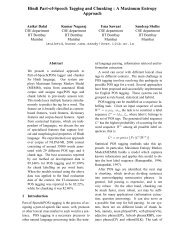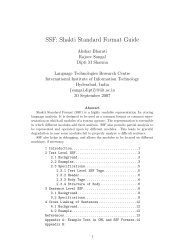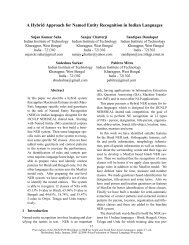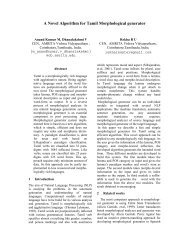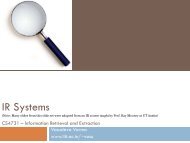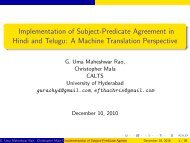WSD of ToInfinitive into Hindi : An Information Based Approach
WSD of ToInfinitive into Hindi : An Information Based Approach
WSD of ToInfinitive into Hindi : An Information Based Approach
You also want an ePaper? Increase the reach of your titles
YUMPU automatically turns print PDFs into web optimized ePapers that Google loves.
question is, is it possible to "guess" the unspecified information just from<br />
the language strings? It is here that the Paninian model gives us insight<br />
about how to frame the rules for a language phenomenon keeping in mind<br />
both its syntactic and semantic considerations. Panini has explicitly<br />
specified the semantics <strong>of</strong> infinitives in his monumental work<br />
ashhTAdhyAyI 3 . We observe that some <strong>of</strong> the cases <strong>of</strong> the English toinfinitive<br />
may be translated as the affix 'tumun' in Sanskrit. Therefore we<br />
look at the rules dealing with tumun from ashhTAdhyAyI to gain further<br />
insight.<br />
There are five rules in the ashhTAdhyAyI stating the meaning <strong>of</strong> 'tumun'.<br />
They are as follows:<br />
1. tumuNNvulau kriyAyAM kriyArthAyAm [bhavishhyati kAle](3310).<br />
'tumun' and 'Nvul' are the affixes attached to the verb denoting an action<br />
which is to happen in the FUTURE and which is the PURPOSE <strong>of</strong> another<br />
action.<br />
S: kR^ishhNaM drashhTuM yAti.<br />
E: goes to see Krishna.<br />
2. sam<strong>An</strong>akartR^ikesshu tumun [ichchhArtheshhu](33158).<br />
'tumun' is affixed to the verb where the other verb denotes the action <strong>of</strong><br />
DESIRE and where the kartA (AGENT) IS SAME FOR BOTH ACTIONS.<br />
S: bhoktum ichchhati.<br />
E: wishes to eat.<br />
3.shakadhR^ishhaGYAglAghaTarabhalabhakramasahaarhaastiartheshhu<br />
tumun (3465).<br />
'tumun' is affixed to the verb in a sentence where the other verb is from the<br />
list <strong>of</strong> shaka etc. (This list is specific to Sanskrit language).<br />
S: bhoktuM shaknoti.<br />
E: can eat.<br />
4. paryAptivacaneshhu alamartheshhu [tumun](3466).<br />
'tumun' is affixed to the verb in a sentence where the related word is<br />
'paryApta' etc. that occur in the sense <strong>of</strong> CAPABILITY.<br />
S: bhoktuM paryAptaH.<br />
E: capable to eat.<br />
5. kAlasamayavelAsu tumun (33167).


